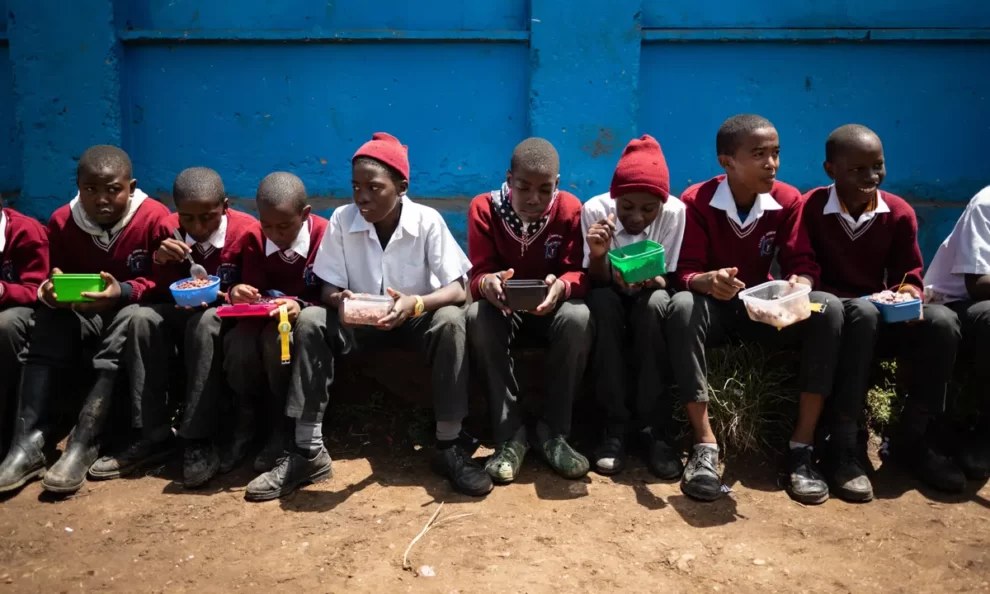As Nairobi’s 4 million residents prepare to sleep, a team of men and women bid their families goodnight and head to a building on the edge of the city’s industrial district. It is here that “the largest green kitchen in Africa” comes to life.
The 3,000 sq metre (32,000 sq ft) “giga-kitchen’s” sustainable energy infrastructure includes the use of eco-friendly scrap wood briquettes to run two boilers to heat water and create the steam needed to cook 60,000 meals a day for Nairobi’s schoolchildren.
The kitchen is run by Food4Education, a Kenyan not-for-profit organisation that began operating the largest school meals programme in Africa this summer in partnership with the national government and several county authorities, which offer subsidies that make the meals more affordable for parents.
The programme provides meals for a quarter of children enrolled in Nairobi’s state schools, the majority of whom come from poor city neighbourhoods. As the city sleeps, dozens of cooks, loaders, cleaners and drivers get to work.
Wawira Njiru was a 21-year-old nutrition and food sciences student in Australia when lectures about the negative effects of bad nutrition on African children pricked her conscience. “I wanted to do something about it but had nothing,” she says. “I was working at three or four jobs to put myself through college and raise some capital to start a school meals programme.”
She held a fundraiser and cooked Kenyan meals including chapatis (an unleavened flatbread originating in the Indian subcontinent but popular in Kenya) for her Australian friends hoping they would buy into her idea. With the money she raised and some personal savings, she built her first kitchen – a corrugated iron sheet structure in her home town of Ruiru, 20km from Nairobi, in 2012.
A picture of that first building is displayed on a wall in the new kitchen. “I thought we would cook and no child would turn up,” Njiru remembers. The kitchen was built close to the local school and fed 25 schoolchildren. “I thought: ‘If only I had the resources to cook for 100’,” she says. “The largest group I had ever cooked for was probably my family.”
In 2017, Njiru visited the Akshaya Patra Foundation, an Indian school lunch programme started in 2000 in Bengaluru, Karnataka, which by 2022 was feeding 2 million children daily. “I saw the Akshaya Patra kitchen and wanted a similar model. I saw the structures including procuring processes, accounting and human resource management. I had none of those,” she says. Since putting those structures in place and creating a dedicated team, Food4Education has been able to prepare and deliver more than 21m meals to date.
Caroline Kinuthia, the kitchen manager, is on the floor by 7am ready to assist her team in ensuring the food is cooked, inspected, loaded and dispatched in a timely manner. But not before reviewing the previous day’s deliveries.
“We review the data coming in from schools, including the number of meals actually taken, as captured by a digital app, Tap2Eat,” says Kinuthia, a nutritionist. Each meal costs about KSh 30 ($0.2) with a parental contribution of KSh 15 credited to a virtual wallet accessible through a smart wristband. School meal managers tap the wristbands to authenticate the balance.
Next, Kinuthia moves to the main storage facility and the first port of call for all deliveries from farmers and general suppliers. On any given school day, the kitchen uses approximately 2,400kg of rice, 1,900kg of beans, 1,800kg of mung beans, 130kg of onions, 170kg of tomatoes, 160kg of carrots and 650kg of cabbages. “Quality comes first,” says Kinuthia. “You can tell the freshness of the vegetables just by looking. The last thing we want is a complaint from even one child about the food quality.”
In the dying hours of the night, Hannah Kamau paces the kitchen’s upper deck, glancing at the food delivery trucks packed at the entrance. It is a race against time to ensure the stew she has been preparing overnight is ready in time for dispatch to the schools.
Easy-to-use vegetable peelers and washers, automated stirrers and other equipment have shortened a cooking process that would otherwise take her extra hours. “Imagine how exhausting this process would be if all processes were manual,” she says.
Kamau, a mother of four, started cooking for Food4Education two years ago at a smaller kitchen that served vulnerable schoolchildren near her home in Dagoretti, a semi-urban settlement to the west of Nairobi. When she started at the new kitchen, she thought of moving closer to her workplace but abandoned the idea at the thought of her children having to change school.
“You have to think of your family. Sometimes you make sacrifices,” she says. “The children I cook for have become like family. Their families struggle with life as I did. I am at peace knowing there is a child who can now concentrate in class because of the food we cook.”
By the time Franklin Mutethia gets into the kitchen, much of the cooking is over. A food loader, his responsibilities include inspecting the food delivery pots and ensuring there is accurate labelling so that the right pots get delivered to the intended schools. Using these, together with the previous day’s reports about the true figures of the food uptake, wastage is kept under 2%.
He and his team also ensure the temperature of the food is kept above 75С as “temperatures lower than that attract harmful bacteria”.
Mutethia, the father of a three-year-old son, grew up in Meru, a county in central Kenya. He never attended college and was jobless before joining the school feeding programme in September. “I was idle most of the time,” he says. “But I have gained enough experience in just a short time. It is not just about money but an opportunity to serve. The food we prepare is making an impact in our society.”
Like a number of the kitchen workers, Meghan Sungu clocks on at 9pm and, after getting feedback about the previous day’s meals, assists in preparing the ingredients for the next one.
Sungu, a mother of three, is among those who work at the rice station, ensuring it is ready by 5am. “We even pray for divine guidance,” she says. “There is no room for error here.”
While the school meal arrangement is ensuring thousands of children are getting fed, Njiru says creating employment for almost 2,000 people within the new kitchen and satellite stations has transformed families in poor neighbourhoods.
“These people only cooked for their families and were shocked when they saw the magnitude of this kitchen,” she says. “Look at how they have adapted.”
Source: The Guardian
















